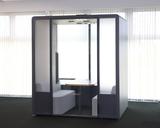News release overview
Hitachi, Iwamizawa City, and Iseki launch proof-of-concept test of local production and consumption of energy from battery cycling
Hitachi develops movable battery capable of supplying renewable energy to dispersed agricultural locations and technology for optimizing charge-discharge plans

Figure 1 Regional use of locally produced and consumed energy from movable AC/DC multi-function batteries
Tokyo, January 25, 2024 – Hitachi Ltd. (TSE: 6501; hereafter "Hitachi") and the City of Iwamizawa in Hokkaido (hereafter "Iwamizawa City") have launched a test, with Iseki & Co., Ltd. (hereafter "Iseki"), to prove the concept of the local production and consumption of renewable energy utilizing battery cycling, with a view to contributing to regional industries that are both environmentally and economically sustainable.
The test will support life in the regions by providing renewable energy from a stand-alone nanogrid*1 to support regional industries not connected to Iwamizawa City's distributed power grid and to supply temporary EV fast-charge stations and other infrastructure. Movable AC*2/DC*3 multi-function batteries developed by Hitachi will be installed in electrical farming equipment provided by Iseki, enabling use of the energy in agriculture during the agricultural busy season, and – by detaching or attaching batteries – in the nanogrid and electrical equipment during the agricultural off-season. The test will use Hitachi's technology for optimizing charge-discharge plans to improve operational efficiency and will address local production and consumption of energy.
Hitachi and Iwamizawa City will use the city as a demonstration site to encourage introduction of the technology to regions where there is increasingly large-scale management of primary industry and also promote electrification of work vehicles, thereby contributing to reducing the effects of soaring fuel and to decarbonization of regional industries.
*1 Stand-alone nanogrid: A small-scale power grid that enables local production and consumption of energy by having one's own energy source using solar power, or gas associated with hot springs.
*2 AC (alternating current): Current and voltage change periodically when electricity flows. Applies in products that are plugged in to an outlet for use.
*3 DC (direct current): Current and voltage are always consistent when electricity flows. Applies in products that use batteries.









